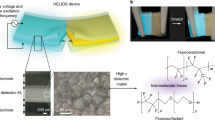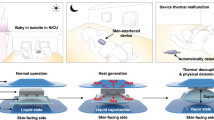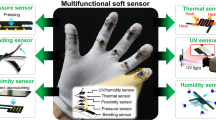Abstract
Inorganic light-emitting diodes and photodetectors represent important, established technologies for solid-state lighting, digital imaging and many other applications. Eliminating mechanical and geometrical design constraints imposed by the supporting semiconductor wafers can enable alternative uses in areas such as biomedicine and robotics. Here we describe systems that consist of arrays of interconnected, ultrathin inorganic light-emitting diodes and photodetectors configured in mechanically optimized layouts on unusual substrates. Light-emitting sutures, implantable sheets and illuminated plasmonic crystals that are compatible with complete immersion in biofluids illustrate the suitability of these technologies for use in biomedicine. Waterproof optical-proximity-sensor tapes capable of conformal integration on curved surfaces of gloves and thin, refractive-index monitors wrapped on tubing for intravenous delivery systems demonstrate possibilities in robotics and clinical medicine. These and related systems may create important, unconventional opportunities for optoelectronic devices.
This is a preview of subscription content, access via your institution
Access options
Subscribe to this journal
Receive 12 print issues and online access
$259.00 per year
only $21.58 per issue
Buy this article
- Purchase on Springer Link
- Instant access to full article PDF
Prices may be subject to local taxes which are calculated during checkout






Similar content being viewed by others


References
Reuss, R. H. et al. Macroelectronics: Perspectives on technology and applications. Proc. IEEE 93, 1239–1256 (2005).
Forrest, S. R. The path to ubiquitous and low cost organic electronic appliances on plastic. Nature 428, 911–918 (2004).
Menard, E. et al. Micro- and nanopatterning techniques for organic electronic and optoelectronic systems. Chem. Rev. 107, 1117–1160 (2007).
Loo, Y-L. & McCulloch, I. Progress and challenges in commercialization of organic electronics. MRS Bull. 33, 653–662 (2008).
So, F., Kido, J. & Burrows, P. Organic light-emitting devices for solid-state lighting. MRS Bull. 33, 663–669 (2008).
Razavi, F. H. et al. Three dimensional nanopillar array photovoltaics on low cost and flexible substrates. Nature Mater. 8, 648–653 (2009).
Ko, H. et al. Flexible carbon nanofiber connectors with anisotropic adhesion properties. Small 6, 22–26 (2010).
Cohen-Karni, T., Timko, B. P., Weiss, L. E. & Lieber, C. M. Flexible electrical recording from cells using nanowire transistor arrays. Proc. Natl Acad. Sci. USA 106, 7309–7313 (2009).
Timko, B. P. et al. Electrical recording from hearts with flexible nanowire device arrays. Nano Lett. 9, 914–918 (2009).
Siegel, A. C., Philips, S. T., Wiley, B. J. & Whitesides, G. M. Thin, lightweight, foldable thermochromic displays on paper. Lab Chip 9, 2775–2781 (2009).
Siegel, A. C. et al. Foldable printed circuit boards on paper substrates. Adv. Funct. Mater. 20, 28–35 (2010).
Hu, L. et al. Highly conductive paper for energy-storage devices. Proc. Natl Acad. Sci. USA 106, 21490–21494 (2009).
Hu, L. et al. Stretchable, porous, and conductive energy textiles. Nano Lett. 10, 708–714 (2010).
Sekitani, T. et al. Stretchable active-matrix organic light-emitting diode display using printable elastic conductors. Nature Mater. 8, 494–499 (2009).
Jacobs, H. O. & Whitesides, G. M. Submicrometer patterning of charge in thin-film electrets. Science 291, 1763–1766 (2001).
Cole, J., Wang, X. & Jacobs, H. O. Patterned growth and transfer of ZnO micro- and nanocrystals with size and location control. Adv. Mater. 20, 1474–1478 (2008).
Leong, T. G. et al. Tetherless thermobiochemical actuated microgrippers. Proc. Natl Acad. Sci. USA 106, 703–709 (2009).
Park, S-I. et al. Printed assemblies of inorganic light-emitting diodes for deformable and semitransparent displays. Science 325, 977–981 (2009).
Dupuis, D. R. & Krames, M. R. History, development, and applications of high-brightness visible light-emitting diodes. IEEE J. Lightwave Technol. 26, 1154–1171 (2008).
Kim, D-H. et al. Materials and noncoplanar mesh designs for integrated circuits with linear elastic responses to extreme mechanical deformations. Proc. Natl Acad. Sci. USA 105, 18675–18680 (2008).
Brown, X. Q., Ookawa, K. & Wong, J. Y. Evaluation of polydimethylsiloxane scaffolds with physiologically-relevant elastic moduli: Interplay of substrate mechanics and surface chemistry effects on vascular smooth muscle cell response. Biomaterials 26, 3123–3129 (2005).
Kim, D-H. et al. Optimized structural designs for stretchable silicon integrated circuits. Small 5, 2841–2847 (2009).
Kim, D-H. et al. Ultrathin silicon circuits with strain-isolation layers and mesh layouts for high-performance electronics on fabric, vinyl, leather, and paper. Adv. Mater. 21, 3703–3707 (2009).
Jeon, B. S., Chun, S. Y. & Hong, C. J. Structural and mechanical properties of woven fabrics employing Peirce’s model. Tex. Res. J. 73, 929–933 (2003).
Gardner, W. R. & Ehlig, C. F. Physical aspects of the irnternal water relations of plant leaves. Plant Physiol. 40, 705–710 (1965).
Cox, H. L. The elasticity and strength of paper and other fibrous materials. Br. J. Appl. Phys. 3, 72–79 (1952).
Hayase, M. et al. Photoangioplasty with local motexafin lutetium delivery reduces macrophages in a rabbit post-balloon injury model. Cardiovasc. Res. 49, 449–455 (2001).
Waksman, R. et al. Photopoint photodynamic therapy promotes stabilization of atherosclerotic plaques and inhibits plaque progression. J. Am. Coll. Cardiol. 52, 1024–1032 (2008).
Woodburn, K. W. et al. Phototherapy of cancer and atheromatous plaque with texaphyrins. J. Clin. Laser Med. Surg. 14, 343–348 (1996).
Overholt, B. F., Panjehpour, M., Denovo, R. C. & Petersen, M. G. Photodynamic therapy for esophageal cancer using a 180° windowed esophageal balloon. Lasers Surg. Med. 14, 27–33 (2005).
Sum, S., Madden, S., Hendricks, M., Chartier, S. & Muller, J. Near-infrared spectroscopy for the detection of lipid core coronary plaques. Curr. Cardiovasc. Imaging Rep. 2, 307–315 (2009).
Waxman, S. et al. In vivo validation of a catheter-based near-infrared spectroscopy system for detection of lipid core coronary plaques: Initial results of the SPECTACL study. J. Am. Coll. Cardiol. Imging 2, 858–868 (2009).
Waxman, S. Near-infrared spectroscopy for plaque characterization. J. Interv. Cardiol. 21, 452–458 (2008).
Corazza, A. V., Jorge, J., Kurachi, C. & Bagnato, V. S. Photobiomodulation on the angiogenesis of skin wounds in rats using different light sources. Photomed. Laser Surg. 25, 102–106 (2007).
Wong-Riley, M. T. T. et al. Photobiomodulation directly benefits primary neurons functionally inactivated by toxins. J. Biol. Chem. 280, 4761–4771 (2005).
Vinck, E. M., Cagnie, B. J., Cornelissen, M. J., Declercq, H. A. & Cambier, D. C. Increased fibroblast proliferation induced by light emitting diode and low power laser irradiation. Lasers Med. Sci. 18, 95–99 (2003).
Schindl, A. et al. Direct stimulatory effect of low-intensity 670-nm laser irradiation on human endothelial cell proliferation. Br. J. Dermatol. 148, 334–336 (2003).
Amir, A. et al. The influence of helium–neon irradiation on the viability of skin flaps in the rat. Br. J. Plast. Surg. 53, 58–62 (2000).
Yao, J. et al. Functional nanostructured plasmonic materials. Adv. Mater. 22, 1102–1110 (2010).
Yao, J. et al. Seeing molecules by eye: Surface plasmon resonance imaging at visible wavelengths with high spatial resolution and submonolayer sensitivity. Angew. Chem. 47, 5013–5017 (2008).
Acknowledgements
We thank T. Banks for help with processing using facilities at the Frederick Seitz Materials Research Laboratory, J. D. Sulkin for help with luminance–current–voltage measurement, H-S. Kim for discussions and C. Conway and D. Stevenson for help with photography. We also thank Georgios A. Bertos, Ph.D., Sr R&D Principal Engineer Technology Resources Engineering, Baxter Healthcare Corporation, for discussions. This material is based on work supported by Ford Motor Company, the National Science Foundation under grant DMI-0328162 and the US Department of Energy, Division of Materials Sciences, under Award No. DE-FG02-07ER46471, through the Materials Research Laboratory and Center for Microanalysis of Materials (DE-FG02-07ER46453) at the University of Illinois at Urbana-Champaign. R-H.K. would like to thank Samsung Electronics for doctoral fellowships. J.A.R. acknowledges support from a National Security Science and Engineering Faculty Fellowship from the Department of Defense. Y.H. acknowledges support from NSF (OISE-1043143 and ECCS-0824129). F.G.O. and D.L.K. acknowledge support from the US Army Research Laboratory and the US Army Research Office under contract number W911 NF-07-1-0618 and by the DARPA-DSO and the NIH P41 Tissue Engineering Resource Center (P41 EB002520). We also thank the NIH P41 Tissue Engineering Resource Center (P41 EB002520) for support of the studies, all of which were conducted under approved animal protocols at Tufts University.
Author information
Authors and Affiliations
Contributions
R-H.K., D-H.K., B.H.K., S-I.P. and J.A.R. designed the experiments. R-H.K., D-H.K., B.H.K., J.X., B.P., J.Y., M.L., Z.J.L., A-P.L., D.G.K., F.G.O., Y.H., Z.K. and J.A.R. carried out experiments and analysis. R-H.K., D-H.K., J.X., R.G., J.Y., Y.H., F.G.O., D.L.K. and J.A.R. wrote the paper.
Corresponding author
Ethics declarations
Competing interests
The authors declare no competing financial interests.
Supplementary information
Supplementary Information
Supplementary Information (PDF 3598 kb)
Rights and permissions
About this article
Cite this article
Kim, RH., Kim, DH., Xiao, J. et al. Waterproof AlInGaP optoelectronics on stretchable substrates with applications in biomedicine and robotics. Nature Mater 9, 929–937 (2010). https://doi.org/10.1038/nmat2879
Received:
Accepted:
Published:
Issue Date:
DOI: https://doi.org/10.1038/nmat2879
This article is cited by
-
Body-conformable light-emitting materials and devices
Nature Photonics (2024)
-
Rotating square tessellations enabled stretchable and adaptive curved display
npj Flexible Electronics (2024)
-
A site-selective integration strategy for microdevices on conformable substrates
Nature Electronics (2024)
-
Wearable and Implantable Light-Emitting Diodes and Their Biomedical Applications
Korean Journal of Chemical Engineering (2024)
-
High-efficiency stretchable light-emitting polymers from thermally activated delayed fluorescence
Nature Materials (2023)

